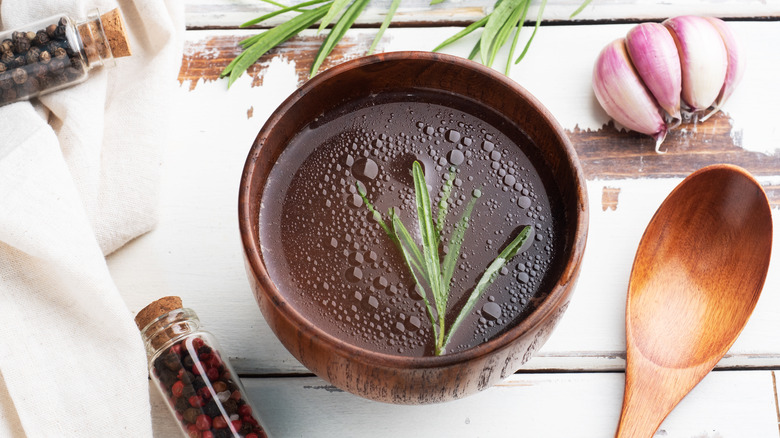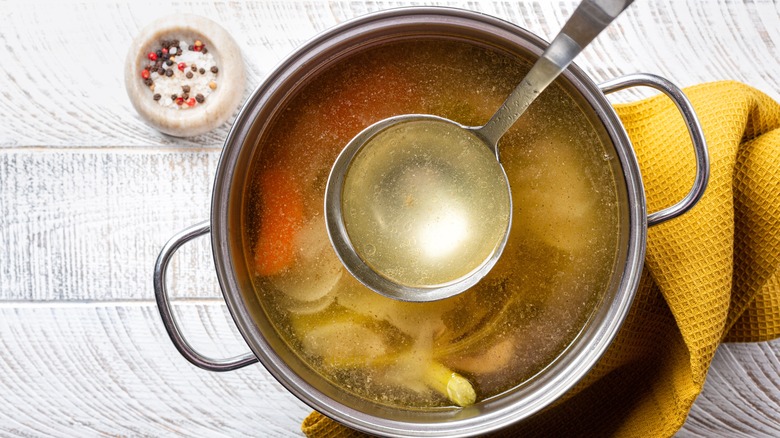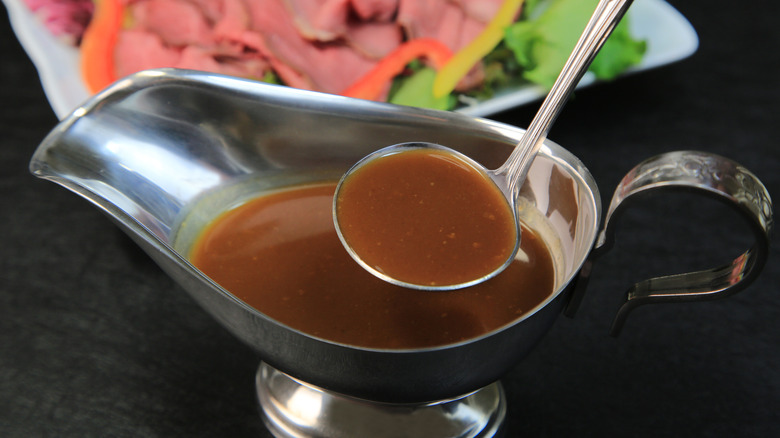This Is What Sets Beef Broth And Au Jus Apart
The line between basic and fancy is often just a matter of vocabulary. In food, that is clear with two things like beef broth and au jus. Beef broth sounds basic: It's a thing you grab from the grocery store for your homemade meals, ideally for cheap, and keep stocked in your pantry alongside staples like beans and pasta. Au jus, on the other hand ... that stuff is fancy. You get au jus in French restaurants or, at the very least, alongside French dip sandwiches with the implication that this has been turned into a true sauce. Au jus is something professionals make.
The reality, of course, is that beef broth and au jus are two very similar products defined more by how and when they are used than anything else, with only minimal differences in production. That doesn't mean beef broth and au jus are identical, just that they are closely related. The two meaty liquids originate from separate processes, and au jus is usually going to be a little more flavorful than your average beef broth. But most of all, they are defined by how they are served, with broth either a meal in its own right or something you turn into other things, while the purpose of au jus is to serve as a sauce for roasts or prime rib, through dipping or pouring over the meal. So no, beef broth and au jus are not the same, though they start from a very similar place.
What is beef broth?
To know what beef broth is supposed to be, it helps to understand one other difference: stock vs. broth. Beef broth is generally a thinner liquid made from the meat of beef cuts along with aromatics like carrots and onions and spices to give it a little more depth. Stock is more based around bones — it can include meat scraps but usually has less salt for seasoning. Broth is also generally cooked for a shorter time. The roasted bones and gelatin in stock give it a more meaty flavor and rich texture, while broth is saltier and gets more of its flavor from the additions beyond the meat.
Both broth and stock can be used as the basis for sauces, but using stock means more seasoning and additional flavors will be needed. Broth can be a soup base, but it needs less additional cooking than stock and should be flavorful enough with all its added ingredients that it can be consumed on its own. Because broth is made simply by simmering meat in liquid with other ingredients, any soup that you make starting with water will technically leave you with broth at the end. So, the big distinction is that while broth can be a basis for other recipes, it is also something you consume by eating directly in the form of a soup.
What is au jus?
In contrast to broth, au jus is a sauce made to complement the main dish. In its original incarnation, it was even more distinct from beef broth. Au jus was a way for French chefs to make use of the pan drippings and meat juice that come from a roast. The pans would be deglazed to make a pan sauce with water or wine, strained to remove excess bits of food, and then cooked down into a simple accompaniment for the meat. Au jus can still be made this way, but modern forms of au jus often start with beef broth for a more complex result, then add spices and other ingredients to increase its flavor. However, unlike beef broth, it is still common to use the pan drippings from meat to add more depth and meatiness to the sauce, although this is not strictly required either.
Despite being a sauce, au jus is not typically thickened with flour like gravy. Sometimes it is kept thin in consistency, and if it is thickened at all, it is done through reduction or with the addition of ingredients like mustard or butter. While the definition of au jus has expanded over time to mean almost any thin sauce paired with meat, its singular purpose of saucing a roast or sandwich without being as thick as gravy is still its primary attribute. Any other purpose, and you are back to calling it beef broth.


